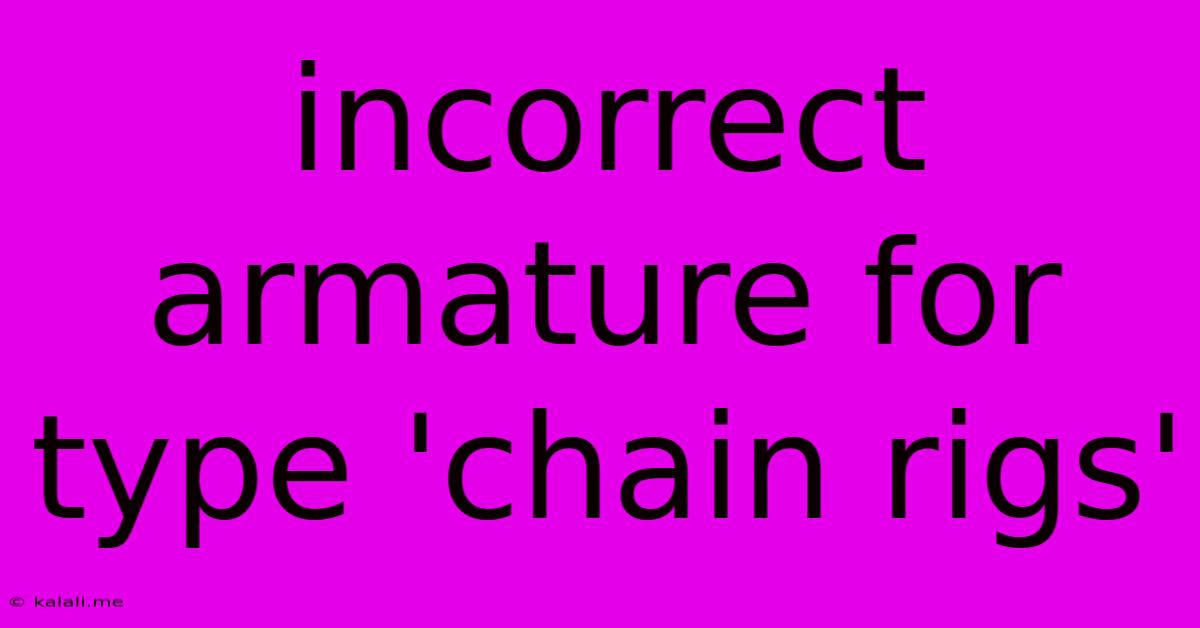Incorrect Armature For Type 'chain Rigs'
Kalali
Jun 01, 2025 · 3 min read

Table of Contents
Incorrect Armature for Type 'Chain Rigs': Troubleshooting and Solutions
This article addresses common issues encountered when rigging characters or objects using chain rigs, specifically focusing on problems arising from incorrect armature setup. Understanding the underlying principles of chain rigs and their proper armature construction is crucial for achieving smooth, realistic animation. Poor armature setup often leads to deformation, unwanted twisting, and generally frustrating animation workflows. We'll explore the most frequent mistakes and offer solutions to help you build robust and reliable chain rigs.
Understanding Chain Rigs and Their Purpose
Chain rigs are a fundamental rigging technique used extensively in 3D animation. They are characterized by a linear arrangement of bones connected sequentially, mimicking a chain or spine-like structure. This type of rig is ideal for limbs, tails, tentacles, or any element that requires smooth, flowing movement along a single axis. However, their simplicity can be deceptive; improper setup leads to significant animation challenges.
Common Mistakes in Chain Rig Armature Construction
Several common errors frequently plague chain rig armatures, resulting in undesirable animation behavior. These include:
-
Incorrect Bone Orientation: Each bone in the chain needs to be correctly oriented along its local axis. Any misalignment will lead to shearing and unnatural bending during animation. Pay close attention to the bone's X, Y, and Z axis orientation during creation. Visual confirmation through the viewport is essential.
-
Insufficient Bone Count: Using too few bones to represent a long, flexible appendage will result in a stiff, unnatural look. More bones allow for finer control and smoother deformation. Consider the level of detail required for your animation. A higher bone count provides greater flexibility but also increases complexity.
-
Uneven Bone Lengths: Inconsistent bone lengths often lead to uneven bending and deformation. Aim for relatively even bone lengths for smoother animation. While slight variations can be stylistic, large discrepancies are usually problematic.
-
Improper Bone Parenting: The hierarchical relationship (parenting) between bones is paramount. Incorrect parenting can cause bones to behave unexpectedly, preventing smooth movement along the chain. Always double-check your bone hierarchy to ensure each bone is correctly parented to the one preceding it.
-
Missing or Incorrect Constraints: While not directly part of the armature itself, constraints play a vital role in controlling the chain rig's behavior. Missing or incorrectly configured constraints can cause limitations in pose manipulation or unexpected deformations.
Troubleshooting and Solutions
Addressing these issues requires careful review and adjustment of the armature. Here’s a breakdown of troubleshooting steps:
-
Visual Inspection: Carefully examine your armature in the viewport from multiple angles. Look for any misaligned bones, uneven lengths, or gaps in the chain.
-
Bone Orientation Check: Use your 3D software’s tools to verify the orientation of each bone. Ensure the X-axis aligns with the primary direction of the chain.
-
Adjust Bone Lengths: If bone lengths are uneven, adjust them to create a more consistent chain. Maintaining relatively uniform lengths is usually optimal.
-
Verify Bone Parenting: Check the parent-child relationships between bones. Incorrect parenting is a frequent source of animation problems.
-
Constraint Review: If using constraints (like IK or stretch constraints), ensure they are correctly configured and applied. Incorrectly setup constraints can significantly impact animation.
-
Rebuilding the Armature: If the problems are significant and difficult to pinpoint, rebuilding the armature from scratch can be a more efficient approach, ensuring a clean and correct setup from the outset.
Preventing Future Problems
By understanding these common pitfalls and implementing the troubleshooting steps, you can significantly improve the quality and reliability of your chain rigs. Remember, meticulous planning and careful construction are key to creating smooth and effective animations. Taking time to properly build your armature will save significant time and frustration later in the animation process. Investing in a well-structured armature is essential for producing high-quality animations.
Latest Posts
Latest Posts
-
Closed Cell Spray Foam Vs Open Cell Spray Foam
Jun 03, 2025
-
Where To Find The Goblin Tinkerer
Jun 03, 2025
-
What To Do With Used Motor Oil
Jun 03, 2025
-
Difference Between Polish And Kosher Dill Pickles
Jun 03, 2025
-
Loop Is Iterating Throuhg Each Character Not Entire Word
Jun 03, 2025
Related Post
Thank you for visiting our website which covers about Incorrect Armature For Type 'chain Rigs' . We hope the information provided has been useful to you. Feel free to contact us if you have any questions or need further assistance. See you next time and don't miss to bookmark.